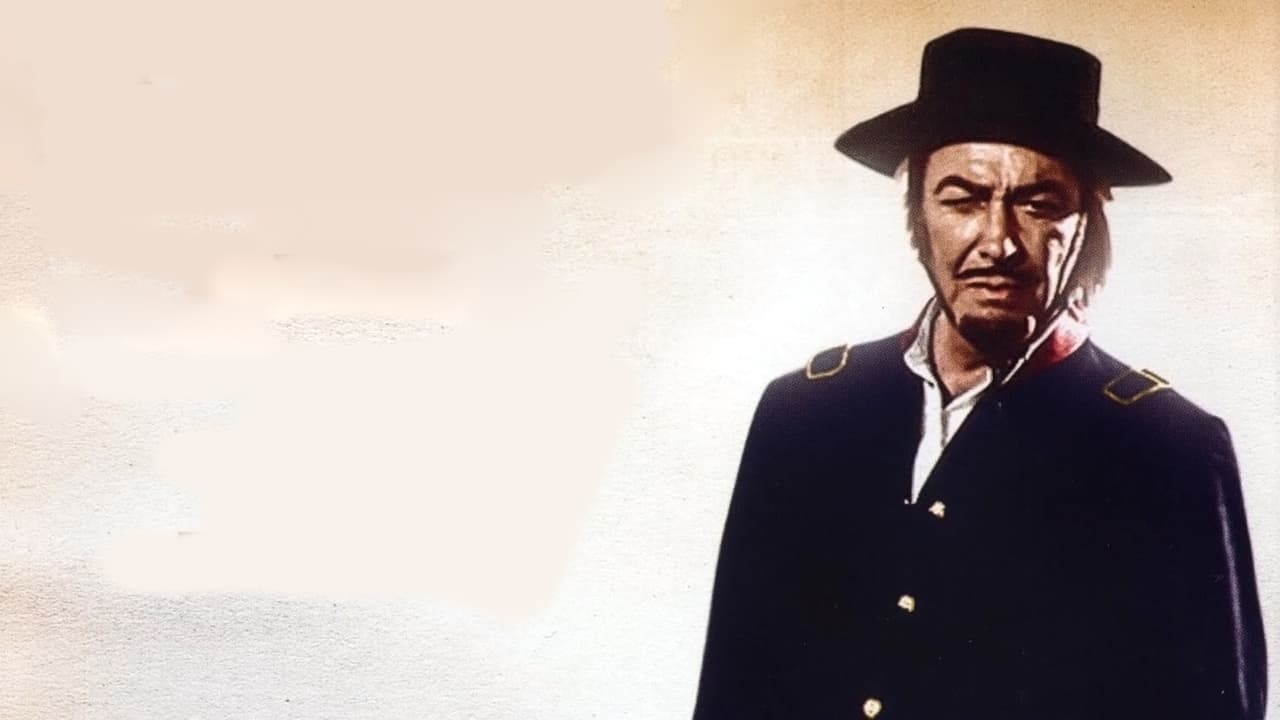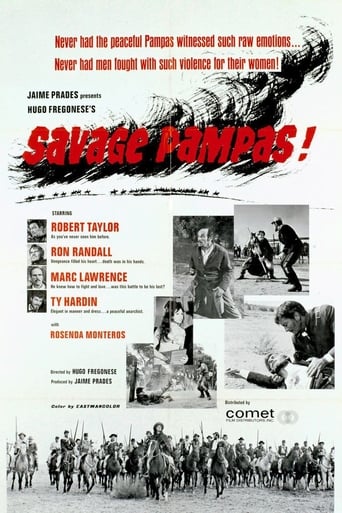


An Argentinian Western and Taylor's oddest film, Savage Pampas is a remake of the 1946 Argentinian film Pampa Barbera. Taylor is the guardian of a wagon train of women heading for a lonely outpost in the interior in 1870. The plot is reminiscent of his Westward the Women (1952) with the difference that this time the women are prostitutes, intended to be morale boosters to stop the men of the outpost from deserting. Shot by Hollywood veteran Fregonese who co-scripted it with a strong emphasis on realism, the film got lost in the flood of Spaghetti Westerns.Phil Hardy
... View MoreI'm familiar with only 2 English language films that deal with the cultural conflicts of the late 19th century pampas regions of Argentina, which were at least as horrific as those on the US plains during the same period. I recently reviewed "Way of the Gaucho", released in '52, and filmed entirely in various regions of Argentina, including the Andes, in Technicolor. The present film was released later and filmed mainly in Spain, in terrain that somewhat resembles the drier pampas, and is about 25 min longer, nearing 2 hours. Both films I caught on Encore Westerns, although they also have DVD releases. Both films deal with the conflicts between the Argentine army and Native Americans, as well as rebellious gauchos, who resisted the ongoing transformation of the Argentine open range into private ownership livestock ranches and grain farms. In both films, army deserters, assigned to the army in lieu of a prison sentence, are an integral part of the story. However, the former film follows the history of one particular deserter and his unlikely relationship with a high class city woman. The present film suggests that army deserters were 'a dime a dozen' without female companionship, and that the Argentine army was mostly composed of former gaucho 'jail sweepings', which I doubt was true. It features a troop of good looking, mostly voluptuous, prostitutes, who are being transported to a frontier fort as 'comfort women', in lieu of jail. In addition, there is another group of plain-looking European women(apparently abducted) brought by a gaucho rebel(Padron) for trade to the Native Americans(NAs) or army deserters. Both the NAs and gaucho rebels want to steal the prostitutes. The NAs attack the patrol, but are beaten off. Later, a huge combined force of NAs and gaucho rebels attack the patrol while they are recuperating in a small village. Thus, NAs play a much bigger role in this film than in "Way of the Gaucho". In both films, they carry long lances and bola slings as their primary weapons, with only the rare bow and arrow.(Historically, they also had some rifles).The cavalry uniforms, with red caps and blue uniforms, look rather similar to those in "Way of the Gaucho", with differences in details. It's remarkable that, although this is supposed to take place in the famous cattle-rich pampas, I remember seeing only one cow in the film!. Actually, the sparsely vegetated terrain doesn't look like it could support many more. It's hardly the 'sea of grass' we imagine the pampas to be. Thus, presumably, we are in the drier interior of Argentina,to where the NAs retreated, as immigrants gradually took over their more desirable lands.Along with the issue of trying to keep the soldiers from deserting to their supposed enemy: the rebel gauchos, the plot involves a somewhat mysterious personal vendetta between Captain Martin(Robert Taylor) and the leader of the rebels (Ron Randell,as Padron). As the padre of the village briefly explains, Martin loved Padron's wife, who hated the pampas as well as Padron, deserting him, and eventually dying of some fever. We should have been given more info on this matter. Also, Padron roped Martin from his horse and dragged him around, just after Martin had killed Padron's brother. Martin was saved by a pursuing soldier, who shot Padron's horse. Later, Padron escaped from the fort, after being staked spread-eagled in the sun. There's plenty of action, dispersed through the film, including several fights between individuals, as well as the mass actions. The climactic tussle between Martin and Padron we expected seems to settle things, after the rest of the deserter-rebels agree to an offered pardon, if they agree to end the siege of the soldiers plus women in the village church. See my review title for the essential result(not telling the specifics). During the stay in the small village, the soldiers and women have an amorous party, the not choosy women having agreed to marry the soldier who picked them out. One of the soldiers does quite a fancy dance on the dining table and floor: perhaps an authentic gaucho dance? Even gruff Martin breaks down, and agrees to their marriages.Ty Hardin plays a Lincoln-looking dandy: an anarchist political prisoner, who gradually becomes sort of Martin's alter ego, until he is killed by Padron. Anarchists and socialists were included in the mass immigration from mostly Spain and Italy during the late 19th century.Mexican and American actress Rosenda Monteros plays a Mayan-looking mysterious silent NA maiden(Rucu), who Martin takes an immediate sexual interest in and buys. She rescues a staked spread-eagled Martin, courtesy of Padron, from certain death. She is also the last person seen in the film, when she slaps her horse on the rump, followed by the horse racing across the wilderness: symbolic of the, as yet, untamed portion of the pampas, and perhaps her own new freedom, perhaps even a magical ritual to insure pregnancy?I don't understand the previous complaints about English dubbing. I had no problem. Chain-smoking Taylor looked prematurely old, especially in the early part, and would die a few years later of lung cancer.
... View MoreSavage Pampas is a film with an unusual setting for the English speaking world, the pampas plains of Argentina at the end of the 19th century. The film is based on a novel Pampa Barbera and was filmed in Argentina before.Robert Taylor is a captain in command of a garrison on the frontier, a whole lot like the American West. But he's having some big troubles. Taylor has a morale problem at the fort, the men are deserting him bit by bit because outlaw chief Ron Randell gives them an outlet for their sexual frustration, women. It's strictly stag at Taylor's post no matter how much he tries to convince the high command in Buenos Aires that his men have needs. It's also to be remembered that most of the men aren't the best quality around. They're not king and country volunteers as Clark Gable put it in Mutiny on the Bounty. In fact a whole lot of them are criminals and were given the choice of the army or prison. Finally he does convince higher ups that some women are essential for morale, so Taylor is given an assignment of escorting some prostitutes let out for that purpose. Of course all this leads up to the inevitable showdown between Taylor and Randell.Taylor in his one and only appearance in a spaghetti western covers some familiar ground. In Westward the Women he escorts some brides to be across the American west. He's the stern and rugged Taylor we've come to know in his later films, tough, but compassionate.The film was photographed in Spain and two other American actors appear in it with Taylor. Marc Lawrence is a sergeant in Taylor's command and Ty Hardin plays an anarchist newspaper editor who accompanies the prostitutes because he's been given a choice, army or jail. Hardin has some biting lines, some of the best in the film and he makes the most of them.It must have been an interesting set on Savage Pampas. On one hand we have Robert Taylor who was a friendly witness at the House Un American Activities Committee. And also Marc Lawrence who's career suffered the effects of the blacklist. I imagine things must have been tense. Other than knowing about Evita Peron and her husband, Argentina or for that matter Latin America in general, is not a history that most Americans are taught. It's still said that Argentina is a frontier country built around a capital city. This picture shows a slice of their frontier life you might not normally be exposed to.For that reason I recommend seeing Savage Pampas. For that reason and because it's one of the last films of one of Hollywood's truly great stars who in his last years was somewhat at sea due to the decline of the studio system.
... View MoreWestern fans may or may not find enjoyment in this dusty, violent mini-epic. Fans of Spaghetti Westerns will likely enjoy it more. The film, which primarily involves the transportation of hookers across Argentinian terrain beset by Indians and rebellious deserters, has a lot going for it and a lot against it. Taylor, in one of his last roles, plays an Army Captain whose chief duty is to defend a fort and keep his men from running off and joining the opposing forces led by renegade Randell. Taylor, an actor who methodically and deliberately did everything he could to ruin his pretty-boy looks, appears wax-like and worn in most of his scenes. His growly voice comes across pretty effectively, but he is almost unbearably stoic through most of the film. However, he is put through some grueling physical torment (when his stunt double isn't doing it) that's somewhat remarkable for someone his age. He also gets off a few decent sarcastic lines, but is hard-pressed to overcome his Abraham Sofaer look and costuming. (At times his hat cord blends in with his goatee making him look like he has a long braided beard! He also has a series of unflattering head scarves which are probably authentic, but don't lend themselves to cinematic authority. Most of the cast wear diaper-like rugs between their legs....another authentic aspect which cuts down on the expectations one may have for a western style film. Some will see this as appealingly different, others may scoff at it.) Randell gets to ham it up a bit in the style that was made famous by Eli Wallach and other stronger actors (with better written parts.) Hardin (bizarrely dressed like a sexy Abe Lincoln) comes along late in the game as an anarchist who is being remanded to Army duty. He has a couple of interesting moments (and a great final scene!), but is mostly wasted. WHY wasn't he in the river with the hookers when they were bathing?? The hookers are a motley group of international actresses. It's hard to drum up much interest in most of them as their characters are only scratched upon. One thing setting apart the interest level in anyone who isn't a name brand star is the atrocious dubbing of the film. This is why those accustomed to Spaghetti Westerns may give the movie higher marks than other viewers. One male actor has a creepy, whispering sound to all of his lines. The ladies mostly have shrill, loud or gravelly voices assigned to them. Any sort of bit part sounds like it was recorded off the street. What's good about the film is it's unusual setting and it's desert scenery. Also, there are certain story elements which come across as unique or at least not overdone. (The Indians use these nasty little ball & rope weapons which are intriguing to see.) A couple of confrontations and action scenes are memorable, even if on an amusing level. (Look out for that head!) What's bad about the film is the aforementioned dubbing, the disjointed nature of the script which makes it hard at first to understand the story, and the choppy editing, unfocused direction and amateurish acting by some of the supporting players. Western diehards should find something to like, but most mainstream filmgoers will find it rough to get through.
... View More